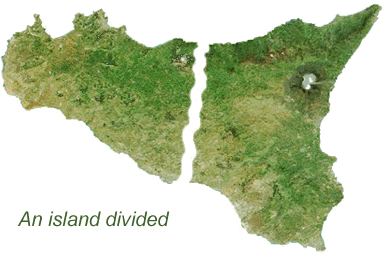...Best of Sicily presents... Best of Sicily Magazine. ... Dedicated to Sicilian art, culture, history, people, places and all things Sicilian. |
by Maria Luisa Romano | ||
Magazine Index Best of Sicily Arts & Culture Fashion Food & Wine History & Society About Us Travel Faqs Contact Map of Sicily
|
Where's the line dividing the two Sicilies? It runs from around Santo Stefano di Camastra southward through the eastern region of the Madonie Mountains, between Enna and Caltanissetta and then southward to Licata. Agrigento is in the western half, Gela in the east. If you live in Enna you probably gravitate toward the shopping, university and bureaucracy of Catania; if you're from Caltanissetta "the city" probably means Palermo. Yet Enna and Caltanissetta are separated, geographically speaking, by barely twenty miles of winding country roads. How did the island become divided in this way? In ancient times the Greeks colonised the eastern areas while the Elymians and Carthaginians occupied most of the west, but Roman influences eventually prevailed over the entire island. Syracuse, the Greeks' great Sicilian city, dominated the landscape for centuries, throughout the Byzantine period. It was the Arabs and Normans who changed this with their focus on Palermo, which they made their capital. During the Middle Ages Messina surpassed Syracuse in importance, to be overtaken, in the eighteenth century, by Catania. The phrase "Two Sicilies" had little to do with this. It came into use following the War of the Vespers, when both the Aragonese dynasty (at Palermo) and the Angevin one (at Naples) claimed the Sicilian Crown, as there was not yet a kingdom "of Naples." As early as the reign of Roger II the entire south of Italy was simply the kingdom "of Sicily." Until 1861 the kingdom that encompassed Sicily and all of southern Italy was technically the "Two Sicilies," though until 1816 it actually had been two distinct states with capitals at Naples and Palermo. Ah, the complexities of history... Returning to the island of Sicily itself, it must be said, in fairness, that its division is really little more than a microcosm of Italy's divisiveness since "unification" around 1860. During the last part of the Second World War (after September 1943), Italy became the only warring nation to fight against itself, with Fascists killing partisans, and the political effects of this are still felt today. With the new federalism there's also a certain lingering ill-feeling between "northerners" and "southerners" aggravated as the economic "divario" (differences in wealth between Italy north and south) widens to an increasingly vast chasm. There's no escaping it. Unfortunately, Italians often take their own regionalist bigotries abroad, so even in America and Australia you sometimes encounter the Catania-against-Palermo mentality or, more frequently, the North-against-South thing dividing Milanese from Palermitans. The autostrada crossing Sicily from east to west has facilitated closer links between Palermo and Catania --now just over two hours away from each other. A motorway linking Palermo with Messina results in similar driving times. Catania has more industry and more large commercial firms than Palermo, which is more of a cultural and political centre. Catania's population is around 400,000. Palermo's is closer to a million, and it is the seat of the Sicilian Regional Assembly, which governs the island with semi-automonous authority. Traditionally, the western part of Sicily (west of Palermo) boasted the island's chief viticultural region, and the Mafia's presence was more strongly felt west of Enna. There are differences in cuisine and even in the accent --Western is slower and gutteral, Eastern perkier and clearer. This kind of thing has led to a number of entrenched and occasionally unpleasant stereotypes: the lazy, corrupt Palermitan versus the honest, hard-working Catanian. The open, cooperative Catanian versus the closed, suspicious Palermitan. And, of course, the slender, stylish Catanian woman versus her fat, tascia Palermitan sister. ("Tascia" is a Sicilian word loosely translated "unsophisticated.") Ah, the complexities of simplistic generalities... About the Author: Maria Luisa Romano has written for various Italian magazines, including this one. | |
Top of Page |
 It's
a Tale of Two Sicilies. An island divided. Not that you'll notice
the phenomenon during a brief visit. But to Sicilians there's a subtle --and
sometimes not-so-subtle-- rivalry, even antipathy, between
It's
a Tale of Two Sicilies. An island divided. Not that you'll notice
the phenomenon during a brief visit. But to Sicilians there's a subtle --and
sometimes not-so-subtle-- rivalry, even antipathy, between